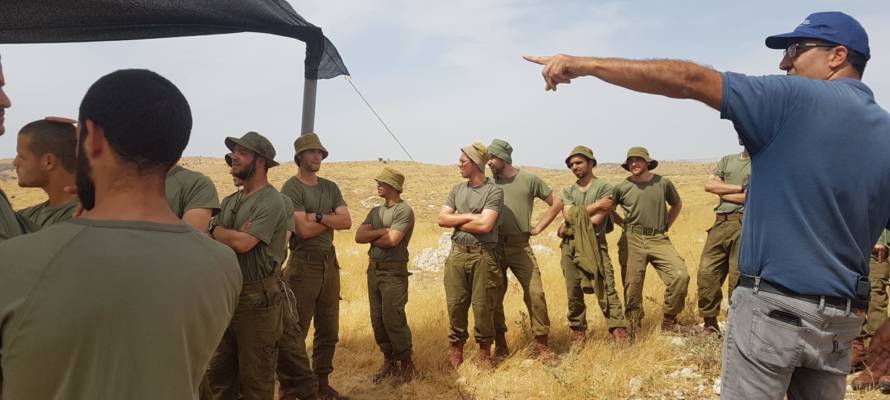Israeli paratroopers in the south uncovered a watchtower that dates back to the time of King Hezekiah in the 8th century BCE.
By United With Israel Staff
Israeli soldiers in the south, along with the Israel Antiquities Authority, uncovered during archaeological excavations a watchtower dating from the time of the Kingdom of Judah (8th century BCE – during the reign of King Hezekiah.)
The excavation was conducted at a paratroopers’ base as part of the ‘Nature Defense Forces Project- Commanders Take Responsibility for their Environment.” The project, led by the Israel Defense Forces’ (IDF) Technology and Maintenance Corps, was carried out in cooperation with the IDF, the Ministry of Defense, the Society for the Protection of Nature in Israel, the Israel Nature and Parks Authority and the Israel Antiquities Authority.
The tower, whose dimensions in antiquity are estimated to have been 5 x 3.5 m, was erected at a high geographic site. As such, it was an observation point to the Hebron Mountains, the Judean plain and the Ashkelon vicinity.
It was mostly built with large stones, some 8 tons in weight, and its height today reaches around 2 m.
According to Sa’ar Ganor and Valdik Lifshitz, excavation directors on behalf of the Israel Antiquities Authority, “The strategic location of the tower served as a lookout and warning point against the Philistine enemy, one of whose cities was Ashkelon.
Biblical Connection
In the days of the First Temple, the Kingdom of Judah built a range of towers and fortresses as points of communication, warning and signaling, to transmit messages and field intelligence.
This tower is one of the observation points connecting the large cities in the area, located in the Beit Mirsim (Mirsham), Tel Eton and Tel Lachish sites. In ancient times, to transmit messages, beacons of smoke were lit during the day and beacons of fire at night. It is probable that the watchtower now uncovered is one of the towers that bore some of the beacons.”
In the Bible, beacons, or, in the language of the Bible, “pillars” are mentioned several times. Thus, in the story of the Concubine in Gibeah, the use of pillars of smoke is described: “The Israelites had arranged with the ambush that they should send up a great cloud of smoke from the city, and then the Israelites would counter attack. The Benjamites had begun to inflict casualties on the Israelites (about thirty), and they said, “We are defeating them as in the first battle.” But when the column of smoke began to rise from the city, the Benjamites turned and saw the whole city going up in smoke” (Judges 20: 38-40).
The prophet Jeremiah also describes the manner in which the beacons were passed: “Flee for safety, people of Benjamin! Flee from Jerusalem! Sound the trumpet in Tekoa! Raise the signal over Beth Hakkerem! For disaster looms out of the north, even terrible destruction.” (Jeremiah 6:1)
Activity in the ancient tower, uncovered in the area of the military base, ceased on the eve of the expedition of Sennacherib, King of Assyria to Judah in 701 BCE.
Archaeological excavations revealed that the entrance to the tower was blocked and the force stationed there apparently converged on one of the nearby fortified towns.
From biblical testimonies and archaeological findings in the area, it is known that Sennacherib’s attack virtually destroyed Judah, including 46 cities and 2,000 villages and farms. Now, some 2,700 years after Sennacherib’s expedition to the Land of Judah, IDF soldiers uncovered an observation tower belonging to Judean army soldiers, similar to the watchtowers used today by the Israeli army.
Inspiring Project
Guy Saly, director of the IDF Nature Defense Forces Project, states that about 150 recruits and commanders from the Paratroopers Brigade, including recruits from commando units, participated in the excavations. This activity lasted several months.
Saly added that the project, which was established with the aim of leading commanders and soldiers to become responsible and actively involved in protecting nature, landscape and the heritage values of their surroundings, began in 2014 with eight projects. Today, as part of this project, sixty activity centers operate across the country.
“To our delight, each project creates solidarity, strengthening the connection between the soldiers and their surroundings,” Saly said. “The IDF, a melting pot of Israel’s diverse population, is a unique meeting place for people from all parts of the country, which, through environmental activities, creates between them a stronger awareness to the preservation of nature and Israeli heritage.”
Second Lieutenant Roi Ofir, age 21, commander of the recruit team in the reconnaissance battalion of the Paratroopers Brigade, said, “The archaeological excavation was a routine break from my point of view. I saw soldiers enjoying manual labor that has added value.This is the first time I participated in excavations. The connection to the land, and the fact that there were Jewish fighters in the past, gave me a sense of mission. The fact that there was also a connection to the area where we carried out our own military maneuvers; left us with a feeling that we were giving back.”
Do You Love Israel? Make a Donation - Show Your Support!
Donate to vital charities that help protect Israeli citizens and inspire millions around the world to support Israel too!
Now more than ever, Israel needs your help to fight and win the war -- including on the battlefield of public opinion.
Antisemitism, anti-Israel bias and boycotts are out of control. Israel's enemies are inciting terror and violence against innocent Israelis and Jews around the world. Help us fight back!























